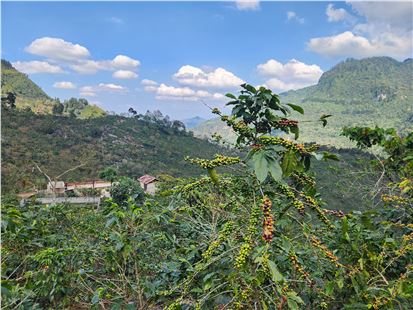BENNETTS ORIGIN REPORT

Find out the latest news from Origin!
ORIGIN TRIP REPORT - GUATEMALA 2025 Coffee made its way to the Americas in the 18th century, eventually being transported by Jesuit priests to their convent, Compañía de Jesús, where it was first used as ornamental shrubs in the mid-1700s. This convent was located in a colonial city that later became known as Antigua. From Antigua, coffee began to spread across the country, finding its way into several other regions, each defined by its unique terroir, resulting in the diverse and distinctive Guatemalan coffees we know today.
During our recent trip to Guatemala, Georgia (our Quality Manager) and Julian (one of our Traders) travelled to the southern region of Antigua to delve deeper into the country's rich coffee origins and terroirs. In Antigua, the farming areas are uniquely positioned between three volcanoes: Agua, Fuego, and Acatenango. Fuego, still active today, regularly blankets the region in mineral-rich ash, enhancing the soil's fertility and boosting the health of the coffee trees. Much of the coffee here is shade-grown, which helps protect the plants from the harsh midday sun and prevents frost damage during cooler months. Antigua coffee, with its sweet fruity notes and milk chocolate finish, is so highly regarded that in 2000, thirty-four historical producers formed the Association of Genuine Antigua Coffee Producers (APCA). This association was established to protect the authenticity of Antigua coffee by limiting the area where it can be grown and granting the region's coffee a Denomination of Origin, officially labelling it as “Genuine Antigua Coffee.” Coffees grown outside of the central region are referred to as "Antigua-type."
Mt Fuego looms behind the drying patios near Antigua
Bringing the coffee down the mountain in Huehuetenango After their time in Huehuetenango, Georgia and Julian returned to the capital before heading south again, this time to the Acatenango Valley region. Like Antigua, this area is heavily influenced by the Fuego volcano, with its frequent eruptions adding vital minerals to the sandy soils, fostering robust tree growth. In Acatenango, much of the coffee is grown under the canopy of forest shade trees, providing an optimal growing environment. The seasonal climate variations here allow for both sun-drying and mechanical drying of coffee, depending on conditions. Acatenango is well-known for its high production volumes compared to neighbouring regions, and the coffees from this area—characterised by rich chocolatey flavours and a heavy, rounded body—are particularly well-suited for espresso roasting.
For many at Bennetts, Guatemalan coffee holds a special place, and our recent visit reaffirmed our belief in the long-term resilience and quality of this origin. With ongoing support from both within the industry and international partners, we’re confident that Guatemala will continue to produce exceptional coffee for years to come. We look forward to our next visit! Happy Roasting,The Bennetts Team |





